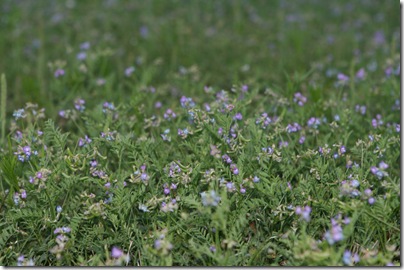Not only have we had more rain recently, but it’s come at the right time. I track the rainfall at our house; for 2008 the total was 16.4 inches, for 2009, 36.7 inches, and for the first 4 months of 2010, 13.6 inches.
All the plants are much greener and thriving like we’ve never seen. For example, we’ve always had a little bit of deer pea vetch. This native plant is an annual and a legume. Like all legumes, it fixes nitrogen and improves the soil. It’s never been very pervasive, however. At one time I thought the seeds had been brought in the top soil that our builder used.
This year, however, it just exploded and grew in thick patches. It grows in long vine-like strands and can be difficult to walk through. And it’s everywhere, not just around the house, but out on the property where the builder did not work. Here’s a photo of a typical patch. If you look closely, you can see the tiny pea pods.

So where did it come from? The answer is Nature’s Seed Bank! The seeds have been in the ground all along, lying dormant, waiting for the right conditions to germinate.
I like to think of the seeds as the genes' escape pods, ejected from the dying mothership, carrying the genes to safety, possibly for many years, until the conditions are right for them to express themselves.
I’m using the deer pea vetch as an example. The Seed Bank has been at work for all plant species, most of which I can’t identify except in broad categories: grasses, wildflowers, forbs.
At this point, in early May, with the days getting hotter, most of the vetch is turning brown and dying, but that’s ok, because the account in Nature’s Seed Bank has been replenished.
Wonderfully dorky analogy.
ReplyDeleteRizzo, thanks for keeping me grounded ...
ReplyDeletePlease keep it up! If you don't Darth Vader from the planet Vulcan will melt your brain!
Sorry ...